Not every aquarist limits their collections to fish. Some branch out to include crustaceans, mollusks, and even reptiles.
If you’ve felt interested in branching out to other species, you may have considered adding aquatic turtles to the mix.
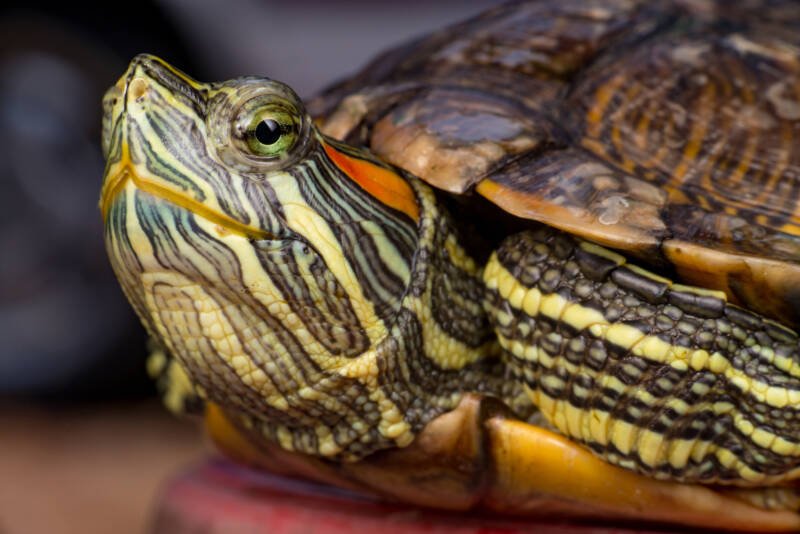
“Aquatic turtle” is a bit of a misnomer. “Aquatic” implies the turtle lives exclusively in the water, never venturing onto land.
However, even sea turtles – the only genuine aquatic turtles – return to land to lay their eggs.
The turtles aquarists usually keep are semi-aquatic.
Aquatic turtles range from temperate to tropical regions around the world. As temperatures drop in colder areas, many go into hibernation.
If you skip an indoor aquarium in favor of an outdoor pond, you’ll see this behavior in action.
In this article
Types of Aquatic Turtles
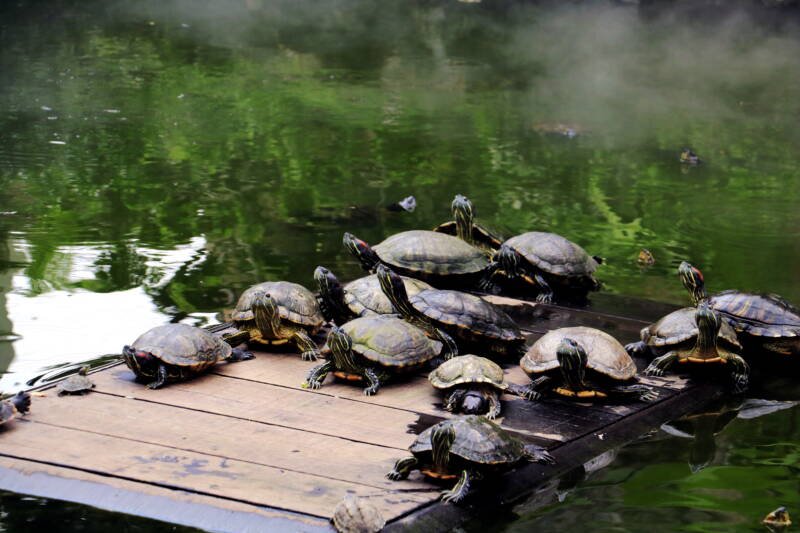
Many aquarists choose to add aquatic turtles to their lives. Reptiles present an additional challenge, balancing land and water temperature needs and managing those crucial UVB lighting needs.
If you choose to bring home a turtle, opt for a captive-bred one from a store instead of catching one yourself.
You’ll run less risk of problems, and you won’t upset the turtle’s innate need to return to its pond.
Avoid any signs of damage to the shell, as these are sites where infection can grow. You also want to skip turtles with discharge from the nose or eyes.
These are problems that require veterinary care, and you don’t want to start on the wrong foot.
1. African Sideneck Turtle (Pelomedusa subrufa)
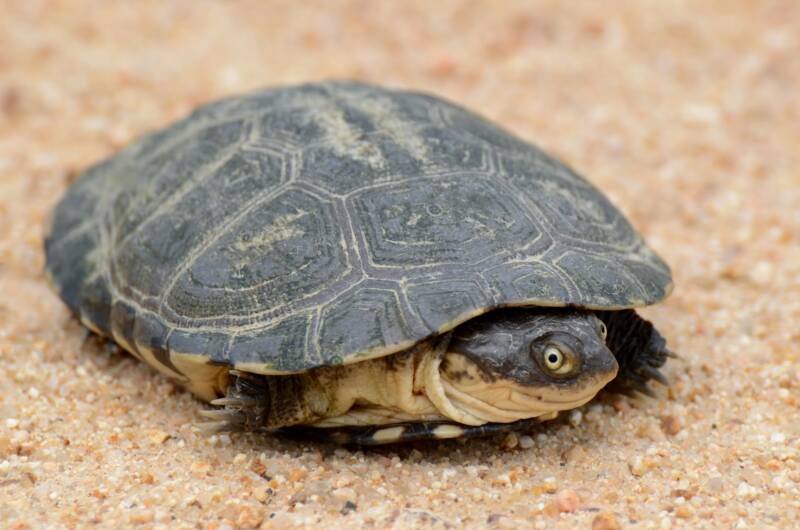
- Difficulty: Moderate
- Temperament: Peaceful
- Diet: Omnivore
- Tank Size: 40 gal (150 l)
- Ambient Temp: 80-85F (27-29C)
- Water Temp: 75F (24C)
- Basking Spot: 95F (35C)
African sideneck turtles charm aquarists with their smiles. They have dramatic webbed feet that propel them through the water.
They’re members of the Pleurodira group of aquatic turtles, which means they can’t retract their heads into their shells.
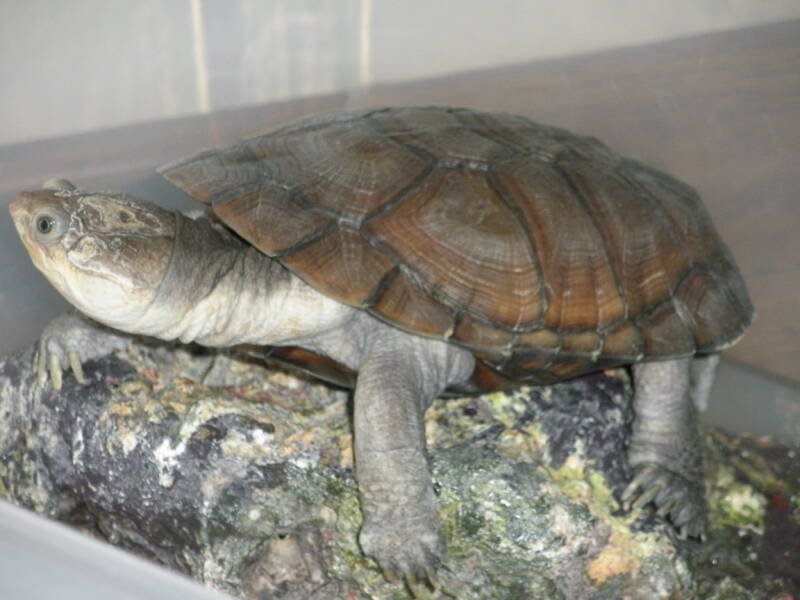
Depending on their age, sidenecks grow from 8-18 inches (20-46 cm) in length. You may need to expand your tank depending on the health of your turtle.
They can live up to 30 years, so an upgrade may be in your future.
This is an aquatic turtle that prefers the meaty side of the menu. They enjoy cooked chicken, beef hearts, and fish, in addition to their daily vegetables.
Make sure you choose healthy sources, though, as you don’t want to introduce possible contamination.
2. Caspian Pond Turtle (Mauremys caspica)
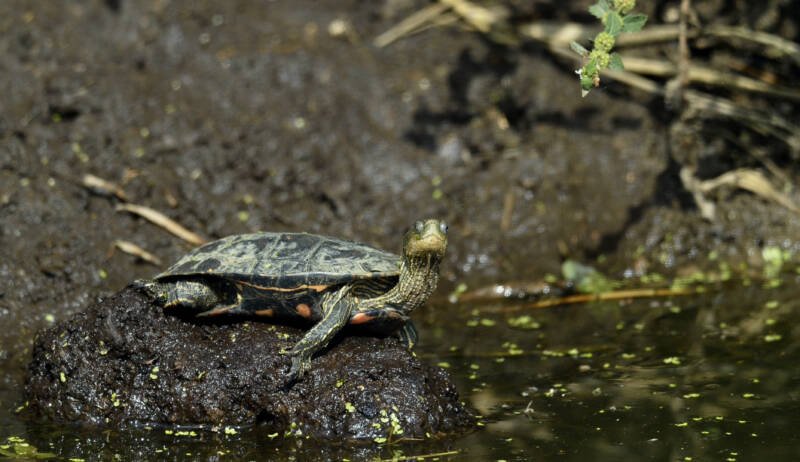
- Difficulty: Moderate
- Temperament: Peaceful
- Diet: Omnivore
- Tank Size: 75 gal (284 l)
- Ambient Temp: 76-86F (24-30C)
- Water Temp: 60-82F (16-28C)
- Basking Spot: 90-100F (32-38C)
Caspian pond turtles have unique tan patterns on their skin and shells.
Native to the Middle East, the species is declining in numbers due to habitat loss.
If you decide to bring one into your aquarium, opt for a captive-bred turtle to prevent further losses to the species.
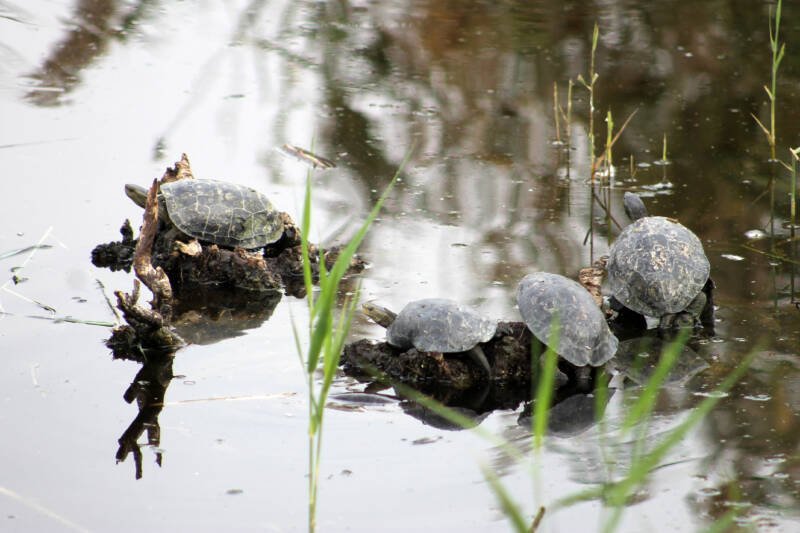
Caspians have distinct personalities, but they’re slow to warm up to their owners.
When startled, they’ll make a dive for the water and attempt to hide behind the decorations. Give them some time to learn your face. You’ll have 40 years together, after all.
Keep the water in your tank as clean as possible. Caspian pond turtles don’t tolerate any waste in their water.
Nor do they enjoy getting handled (which you’ll have to do if they get sick). They bite when stressed.
3. Mississippi Map Turtle (Graptemys pseudogeographica)
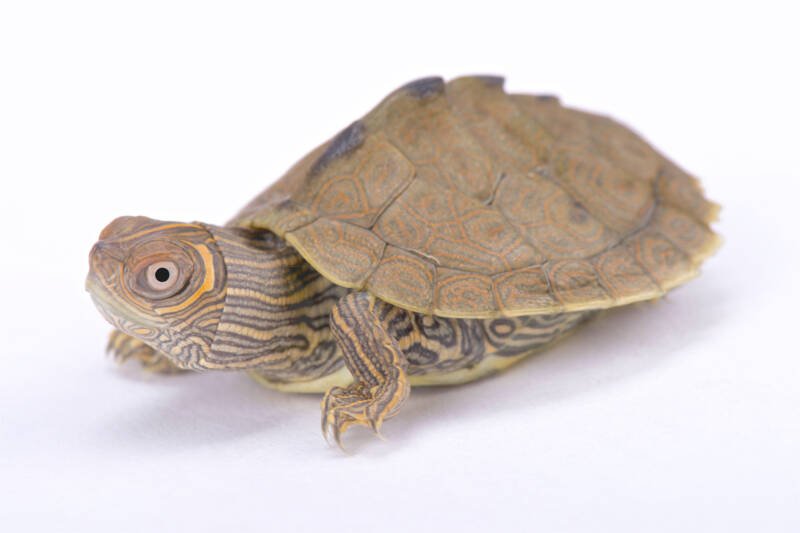
- Difficulty: Moderate
- Temperament: Peaceful
- Diet: Omnivore
- Tank Size: 25 gal (95 l)
- Ambient Temp: 80-85F (27-29C)
- Water Temp: 75F (24C)
- Basking Spot: 85-95F (29-35C)
Map turtles earn their name from the lines tracing their skin and shells. These lines resemble the contour lines on a map.
The Mississippi map turtle falls into one of the subspecies of false map turtle – though it carries the identifying map lines.
If you stick to a male turtle, then a smaller tank will see you through their entire anticipated 33 years.
However, females get twice as large as males reaching 10 inches. Even a single female map turtle requires a 75-gallon (284 l) tank.

Map turtles are one of the shyer aquatic turtles out there. You won’t get as much interaction with them as you might one of the other species.
You also MUST keep the water pristine. The slightest build-up of waste can lead to health problems.
4. Painted Turtle (Chrysemys picta)
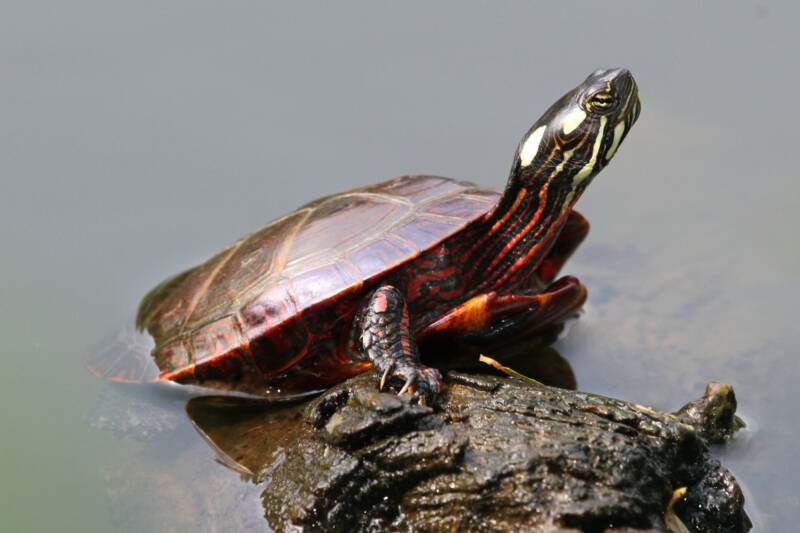
- Difficulty: Easy
- Temperament: Peaceful
- Diet: Omnivore
- Tank Size: 20 gal (76 l)
- Ambient Temp: 75-85F (24-29C)
- Water Temp: 75F (24C)
- Basking Spot: 95F (35C)
The region your painted turtle comes from determines which subspecies you’ll get. There are four of them, divided into eastern, midland, southern, and western.
All of them have black shells marked with yellow and red patterns around the edges.
Painted turtles cover the entire North American continent, hibernating during the winter.
At an adult length of 10 inches (25 cm), they’re slightly smaller than sliders, and they aren’t as demanding in their care needs.
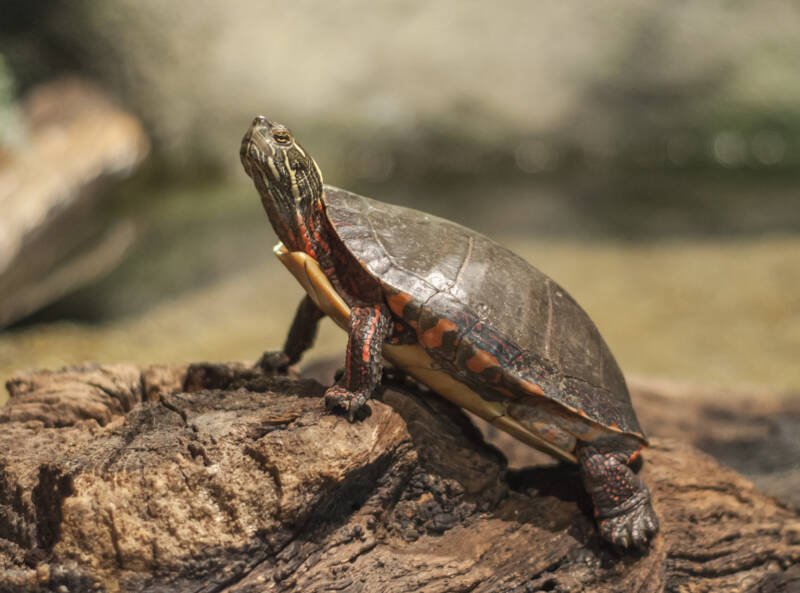
Painted turtles have an average lifespan between 25-30 years, though some have survived up to 55 years.
They remain active throughout the day, which appeals to a lot of people. Especially as no two patterns are quite the same.
5. Razor-Backed Musk Turtle (Sternotherus carinatus)

- Difficulty: Easy
- Temperament: Peaceful
- Diet: Carnivore
- Tank Size: 30 gal (114 l)
- Ambient Temp: 75-80F (24-27C)
- Water Temp: 73-78F (23-26C)
- Basking Spot: 90F (32C)
Musk turtles earned their name from their scent glands. Whenever threatened, they release a pungent odor. Which is why you may also find them listed under the name Stinkpot turtle (quite glamorous).
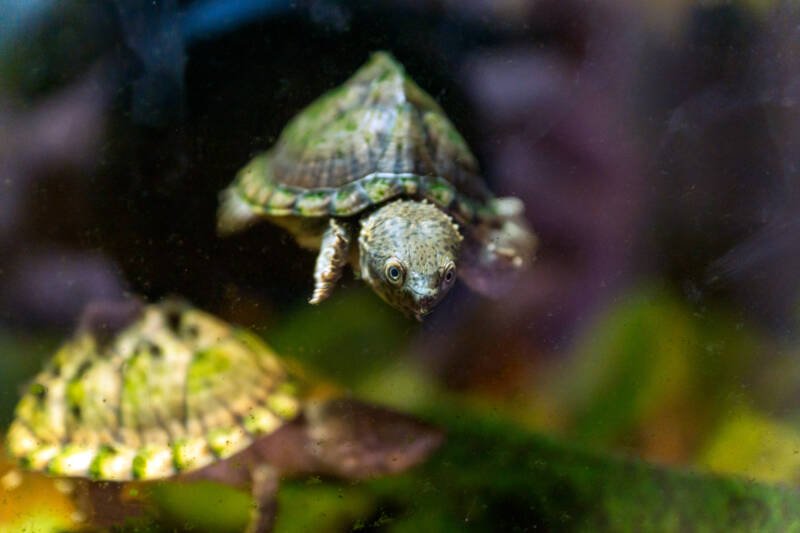
Musk turtles aren’t the largest aquatic turtle, rarely topping 6 inches (15 cm) at full growth. And they aren’t particularly attractive.
They appeal to aquarists due to their habit of staying submerged. Rather than swimming, they crawl along rocks on the bottom.
Similar to map turtles, musk turtles have a shy demeanor – they DON’T like handling (remember those scent glands?).
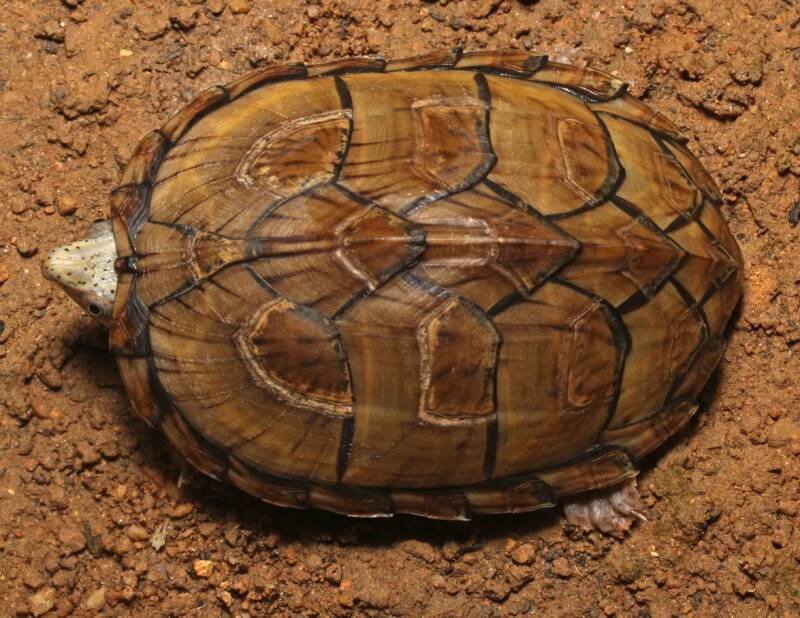
They’re also carnivorous, and they won’t hesitate to nip at you in protest.
While on the easy side to manage, they aren’t recommended for younger children.
6. Red-Eared Slider (Trachemys scripta elegans)

- Difficulty: Moderate
- Temperament: Peaceful
- Diet: Omnivore
- Tank Size: 20 gal (76 l)
- Ambient Temp: 75-80F (24-27C)
- Water Temp: 75-84F (24-29C)
- Basking Spot: 90F (32C)
Red-eared sliders or red-eared terrapins hold the top aquatic turtle spot in the United States.
Their name comes from the two red patches on either side of the head (ignoring the fact that turtles lack ears).
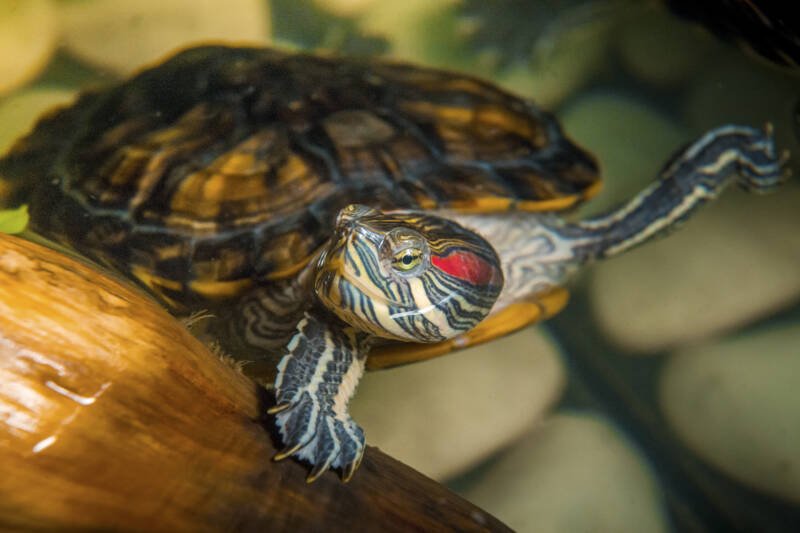
Their shells have green undertones with yellow stripes, making them beautiful little reptiles.
Juveniles start small in pet stores, but once fully grown, your slider will top out around a foot (30.5cm).
They prefer slow-moving waters in their natural range (the Gulf of Mexico east to the Atlantic), and they gravitate toward marshes and ponds.
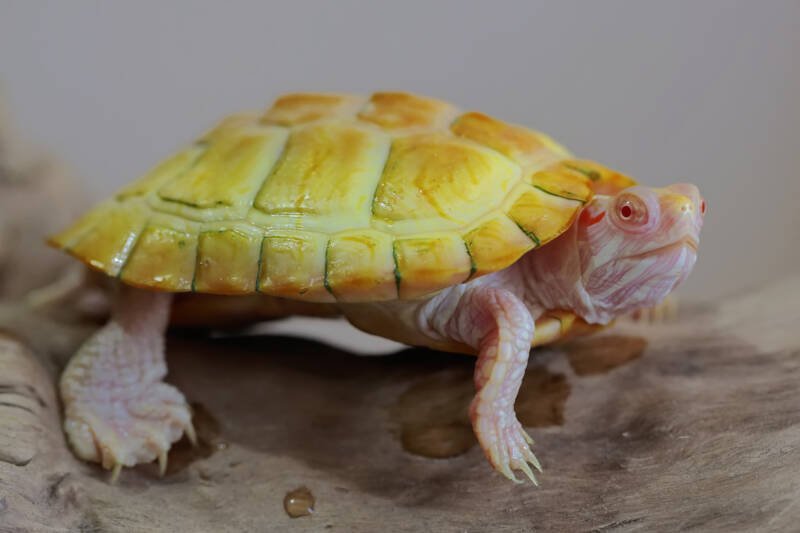
Sliders take time to warm up to you, but then they form close bonds with their owners. With a lifespan of up to 70 years, they also require a hefty investment on your part.
Unfortunately, they’re one of the most abused aquatic turtle species – often dumped in the wild.
7. Reeves Turtle (Mauremys reevesii)

- Difficulty: Easy
- Temperament: Peaceful
- Diet: Omnivore
- Tank Size: 50 gal (189 l)
- Ambient Temp: 75-85F (24-29C)
- Water Temp: 70-80F (21-27C)
- Basking Spot: 85-95F (29-35C)
The Reeves turtle comes from the southeastern region of Asia. Their skin and shell have a dark color, with thin yellow lines along the sides of their heads.
They breed readily in captivity, making them one of the most popular aquatic turtles.
These turtles don’t take up a lot of space. As adults, they reach a total length of 6 inches (15 cm).
They also prefer slower waters, making them one of the easier species to keep. Just make sure you choose a quality filter.
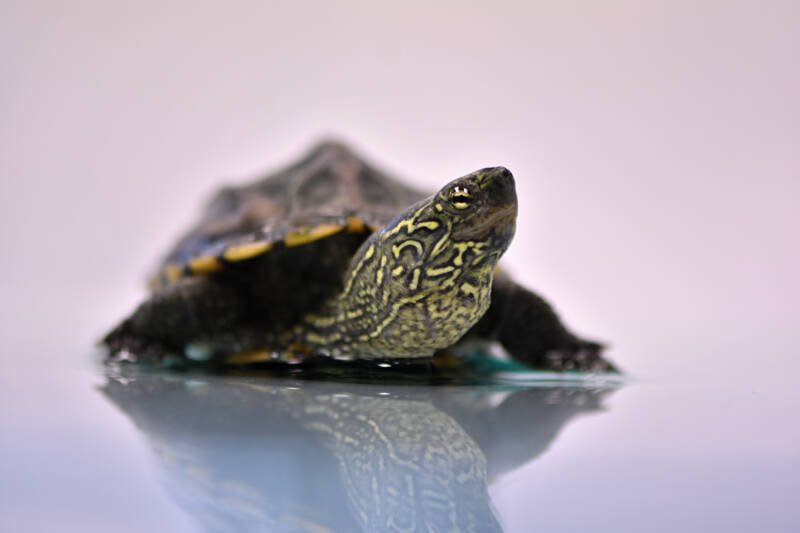
Unlike other species of aquatic turtles, Reeves enjoy having their heads stroked.
They warm up to you quickly, and they’re partial to human contact. Which is probably one of the reasons they top the popularity list.
8. Wood Turtle (Glyptemys insculpta)
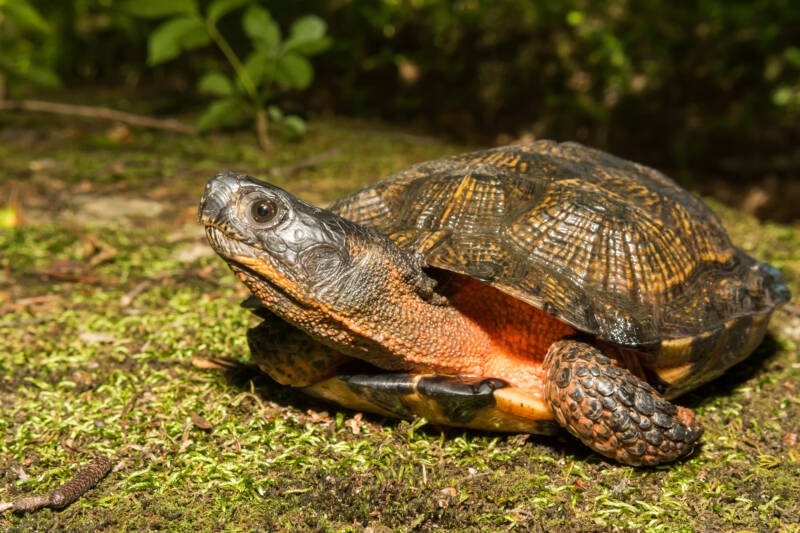
- Difficulty: Moderate
- Temperament: Peaceful
- Diet: Omnivore
- Tank Size: 75 gal (284 l)
- Ambient Temp: 76-86F (24-30C)
- Water Temp: 75F (24C)
- Basking Spot: 90F (32C)
Wood turtles have vibrant red stripes on their skin and shells, resembling wood panels.
There are four subspecies of wood turtle, but the ornate wood turtle tops the charts in popularity. All four range throughout Central America, enjoying tropical climes.
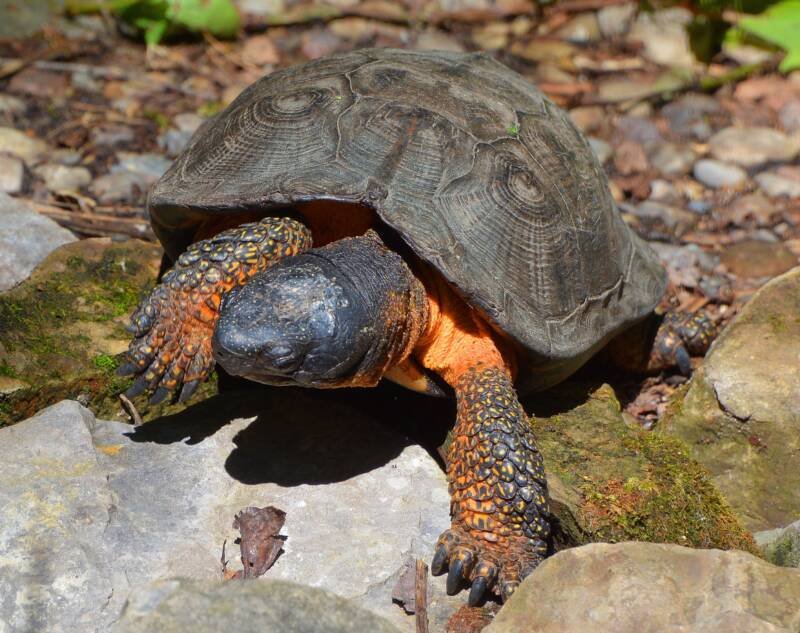
The best way to keep wood turtles is to provide an indoor AND outdoor enclosure.
However, that need for tropical temperatures prevents most aquarists from meeting such a standard. As such, you’ll need a LARGE aquarium to provide plenty of space.
Wood turtles display a high level of intelligence – which is why they’re so popular.
They lean towards the meatier end of the omnivore menu, but you’ll never see one turn down a strawberry or banana. Try to keep the diet as varied as possible.
A Watery Existence
In comparison to land-based tortoises, aquatic turtles have evolved into a watery environment.
They carry the standard features of a reptile (cold-blooded temperature needs and a three-chambered heart), but they’ve adapted to spending most of their lives in the water.

Aquatic turtles have a slower metabolism than other reptiles. This allows them to maximize the length of each breath they take.
Even tropical species lower their metabolic needs, staying underwater for extended periods.
Some species can absorb oxygen from the water through their mouths and cloaca.
They have a high blood vessel concentration in those areas, allowing for oxygen exchange, similar to the labyrinth organ found in gouramis and bettas.
The Turtle Tank
Turtles require A LOT of space. Like most reptiles, they grow throughout their lives.
This means you’ll need to upgrade your aquarium or purchase one large enough to hold your aquatic turtle’s anticipated adult size.
The best option for aquatic turtles is an outdoor pond. However, not everyone lives in the appropriate climate to accommodate their favorite species.

If you lack the necessary warmth (and space), you need to set up the perfect indoor turtle tank.
Choosing the Tank
Like the golden rule of fish size, there’s a rule for selecting a tank for aquatic turtles.
You want to select 10 gallons (38 l) for every inch (2.5 cm) of shell length.
You need an appropriate depth, too. Aim for 2 to 2.5 times deeper than your turtle’s shell length.
Turtle Tank Filter
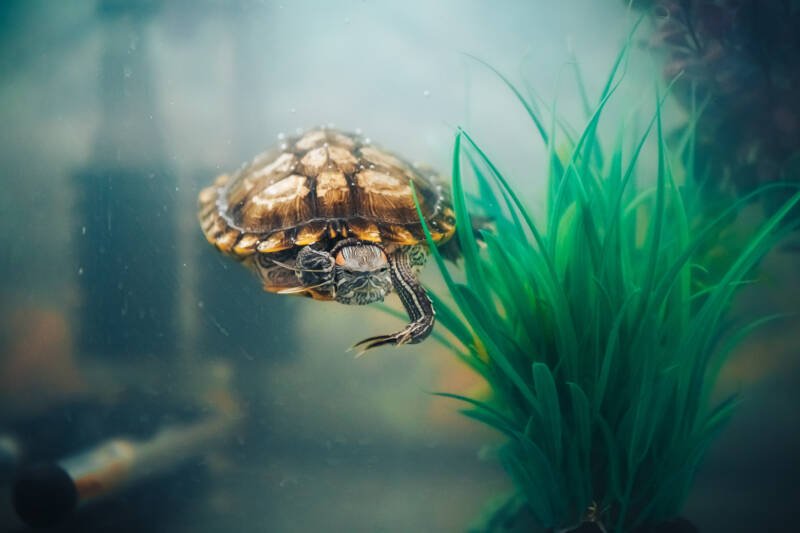
More than even a colorful community tank, turtles produce waste. A LOT of waste.
You’re going to need to invest in the best possible filter to keep your tank clean. As with other reptiles, turtles are messy.
Keeping up with a heavy waste load necessitates all three kinds of media in your filter: biological, chemical, and mechanical.
You want a filter that can handle THREE TIMES your tank size, and it needs to cycle TEN TIMES an hour, at a minimum.
You have three options when it comes to filters.
HOB Filter
You CAN find HOB filters that use all three types of media. The tricky part comes with mounting the filter.
HOB filters need to sit at the water level, but turtle tanks don’t fill to the top.
Canister Filter
You have to spend the most money, but canister external filters function the best for aquatic turtles.
They hold all three media types, they’re easy to access and change, and you can find them with the power you need.
Submersible Filter
If you have a juvenile turtle and a tank smaller than 50 gallons (189 l), you might get away with an internal filter.
You’ll find yourself changing out the media frequently (more than in a fish tank), but it’s an option.
Lights, Heat, Docking
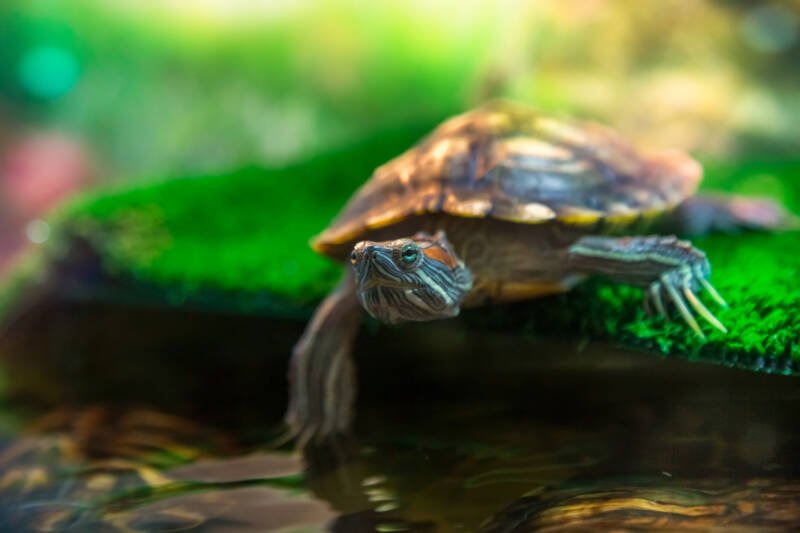
All reptiles are cold-blooded. They rely on the environment around them to provide heat.
It’s easy enough to add a heater to your aquarium, but what about those times when your aquatic turtle feels like exiting the water?
Your turtle tank needs a dock and a basking lamp. The dock provides your turtle a way to safely climb out of the water and rest under their heat source.
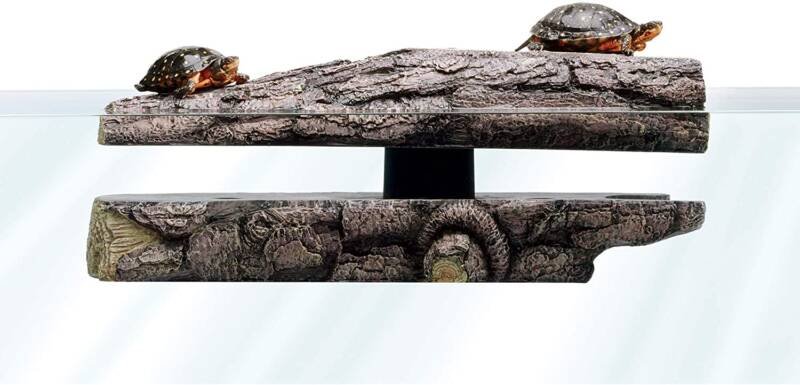
The variety of turtle docks range from natural to futuristic in appearance, and you can decide on the option you prefer.
Basking lamps have more stringent requirements. Every aquatic turtle has a basking temperature, and you’ll need to meet that range.
Your basking light can’t go higher than 12 inches (30 cm) above the tank, or heat starts to bleed away. And heat WON’T conduct through the glass.
No aquatic turtle wants to bake in its shell, though. This means the dock and lamp need to stay on ONE side of the tank.
You’ll create a temperature gradient so your turtle can choose to move to the cooler side.
UVB
As if you haven’t filled your electrical outlets to bursting, your aquatic turtles have one more critical need: a UVB light.
Ultraviolet light provides several essential functions:
- Encourages their natural behaviors, including eating
- Allows synthesis of Vitamin D3
- Strengthens their shell and allows bone growth.
Full-spectrum lights may or may not work. Turtles need 3-8% UVB light to remain healthy.
Too little, and they won’t survive long. If you see desert or tropical lighting options, choose the tropical lights – they have higher UVB concentrations.
When setting up your lights, consider placement carefully. Similar to your basking lamp, you can’t use a glass top. The UVB spectrum won’t absorb through the glass.
Even fine mesh can block UVB rays. Choose a wider mesh. It’ll keep your turtle inside and let the UVB light through.
Aquatic Turtle Feeding

Aquatic turtles span the diet spectrum from herbivore to carnivore.
What makes them unique (and fun) is they only feed in the water. It creates a mess (which is why your filter’s so crucial), but it’s entertaining.
You have plenty of options for feeding your turtle. Research your species’ menu preferences first, but then change things around to keep them interested.
Top turtle favorites include:
- Bloodworms (frozen or freeze-dried)
- Commercial turtle foods
- Crickets
- Dandelions
- Duckweed
- Feeder fish
- Grasshoppers
- Krill
- Romaine lettuce
- Snails
- Shrimps
- Worms
All turtles need calcium to grow their shells. You can gut-load or dust insects with calcium, but floating a cuttlebone in the water works better.
Your turtles can chew on it to their heart’s content, and they’ll absorb additional calcium from the water as it dissolves.
Begging Behavior
Aquatic turtles learn to recognize feeding time. They also develop begging habits. Obesity leads to severe health problems, not to mention the extra waste you’ll find floating in the tank.
Regardless of how adorable that begging looks, avoid overfeeding your turtles.
Your turtle’s stomach is the size of its head. That means you only need to offer the same volume of food as your turtle’s head.
A happy, healthy aquatic turtle never turns down food, so as long as it pokes its head up come feeding time, you’re providing the right amount.
Aquatic Reptiles
Adding aquatic turtles to your tank or setting up a separate aquarium can challenge your aquarist skills.
Turtles have different needs than fish, and they require more attention to regular cleanings.
They provide more interaction than your tetras, though, which some people crave.
Have you decided to keep an aquatic turtle? What’s your tank look like?
Share your experiences below!